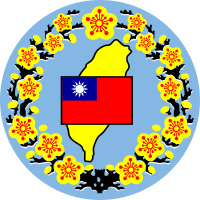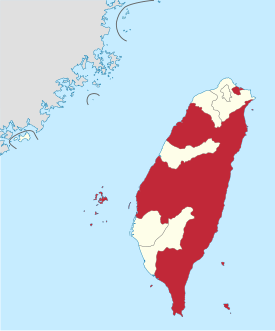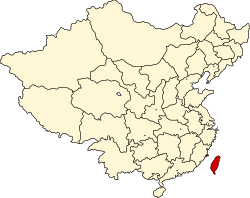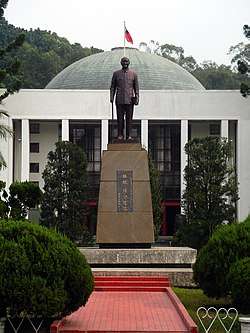Taiwan Province
Taiwan Province (Chinese: 臺灣省; pinyin: Táiwān Shěng; Pe̍h-ōe-jī: Tâi-oân-séng; PFS: Thòi-vàn-sén or Thòi-vân-sén) is a nominal province of the Republic of China without administrative function. Its administrative powers have been transferred to the central and county governments.
Taiwan Province 臺灣省 | |
|---|---|
 Flag  Seal | |
 Map depicting subdivisions nominally part of the province (red) | |
| Coordinates: 23.8°N 121.0°E | |
| Country | Republic of China |
| Established | 1945-10-25 |
| Streamlined | 1998-12-21 |
| Government dissolved | 2018-07-01[1] |
| Provincial capital | None[lower-alpha 1] |
| Government | |
| • Body | None[lower-alpha 2] |
| Area | |
| • Total | 25,110.0037 km2 (9,695.0266 sq mi) |
| Population (2020) | |
| • Total | 7,060,473 |
| • Density | 280/km2 (730/sq mi) |
| Demonym(s) | Taiwanese |
| Time zone | UTC+8 (Asia/Taipei) |
| Cities | 3 |
| Counties | 11 |
| Taiwan | |||||||||||||||||||||||||||||||||||||||||||||||||||||
|---|---|---|---|---|---|---|---|---|---|---|---|---|---|---|---|---|---|---|---|---|---|---|---|---|---|---|---|---|---|---|---|---|---|---|---|---|---|---|---|---|---|---|---|---|---|---|---|---|---|---|---|---|---|
.svg.png) "Taiwan" in Traditional (top) and Simplified (bottom) Chinese characters | |||||||||||||||||||||||||||||||||||||||||||||||||||||
| Traditional Chinese | 臺灣 or 台灣 | ||||||||||||||||||||||||||||||||||||||||||||||||||||
| Simplified Chinese | 台湾 | ||||||||||||||||||||||||||||||||||||||||||||||||||||
| Postal | Taiwan | ||||||||||||||||||||||||||||||||||||||||||||||||||||
| |||||||||||||||||||||||||||||||||||||||||||||||||||||
| Abbreviation | |||||||||||||||||||||||||||||||||||||||||||||||||||||
| Traditional Chinese | 臺 or 台 | ||||||||||||||||||||||||||||||||||||||||||||||||||||
| Simplified Chinese | 台 | ||||||||||||||||||||||||||||||||||||||||||||||||||||
| |||||||||||||||||||||||||||||||||||||||||||||||||||||
| Taiwan Province | |||||||||||||||||||||||||||||||||||||||||||||||||||||
| Traditional Chinese | 臺灣省 or 台灣省 | ||||||||||||||||||||||||||||||||||||||||||||||||||||
| Simplified Chinese | 台湾省 | ||||||||||||||||||||||||||||||||||||||||||||||||||||
| |||||||||||||||||||||||||||||||||||||||||||||||||||||
Taiwan Province covers approximately 69% of the actual-controlled territory of the Republic of China, with around 31% of the total population. The province initially included the island of Taiwan (Formosa), Penghu (the Pescadores), Orchid Island, Green Island, Xiaoliuqiu Island, and their surrounding islands. Between 1967 and 2014, six special municipalities (Kaohsiung, New Taipei, Taichung, Tainan, Taipei and Taoyuan) were split off from the province, all in the most populous regions.
The Taiwan Provincial Government was established in September 1945, after the Japanese rule. It was streamlined in December 1998, with administrative functions transferred to the National Development Council and other ministries of the Executive Yuan. In July 2018, the government was dissolved, with budget and personnel removed.[2]
History
Qing Empire
In 1683, Zheng Keshuang (third ruler of the Kingdom of Tungning and a grandson of Koxinga), surrendered to the Qing Empire following a naval engagement with Admiral Shi Lang. The Qing then ruled the Taiwanese archipelago (including Penghu) as Taiwan Prefecture of Fujian Province. In 1875, Taipeh Prefecture was separated from Taiwan Prefecture. In 1885, work commenced under the auspices of Liu Ming-chuan to develop Taiwan into a province. In 1887, the island was designated as a province (officially Fokien-Taiwan Province), with Liu as the first governor.[3] The province was also reorganized into four prefectures, eleven districts, and three sub-prefectures.[4][5] The provincial capital, or "Taiwan-fu", was intended to be moved from the south (modern-day Tainan) to the more central area of Toatun (modern-day Taichung) in the revamped Taiwan Prefecture.[6] As the new central Taiwan-fu was still under construction, the capital was temporarily moved north to Taipeh (modern-day Taipei), which eventually was designated the provincial capital.
| Circuit | Prefectures | Districts | Sub-Prefectures |
|---|---|---|---|
| Taiwan | Taipeh | Tamsui | Kelung |
| Gilan | |||
| Hsinchu | |||
| Taiwan | Taiwan (臺灣縣) | ||
| Changwha | Puli | ||
| Yunlin | |||
| Miaoli | |||
| Tainan | Anping | Penghu | |
| Kagi | |||
| Fengshan | |||
| Hengchun | |||
| Taitung | |||
Empire of Japan
In 1895, the entire Taiwan Province, including Penghu, was ceded to Japan following the First Sino-Japanese War through the Treaty of Shimonoseki. Under Japanese rule, the province was abolished in favour of Japanese-style divisions. After the surrender of Japan in 1945, the Taiwan was handed over to the Republic of China (ROC). The way that the ROC obtained Taiwan is a subject of controversy that gave root to the complex unresolved political status of Taiwan and the Taiwan independence movement.
Republic of China

The ROC government immediately established the Taiwan Provincial Government under first Chief Executive and government-general Chen Yi in September 1945.[8][9] Chen was extremely unpopular and his rule led to an uprising – the February 28 Incident of 1947. Chen was recalled in May 1947 and the government-general position was abolished.
When the Republic of China government was relocated to Taipei in 1949 as a result of the Kuomintang's (KMT) defeat by the Communist Party of China forces in the Chinese Civil War, the provincial administration remained in place under the claim that the ROC was still the government of all of China even though the opposition argued that it overlapped inefficiently with the national government.
The seat of the provincial government was moved from Taipei to Zhongxing New Village in 1956. Historically, Taiwan Province covers the entire island of Taiwan and all its associated islands. The city of Taipei was split off to become a province-level special municipality in 1967, and the city of Kaohsiung was split off in 1979 to become another special municipality. In December 2010, Kaohsiung County left the province and merged with the original Kaohsiung City to become an expanded Kaohsiung City, Taipei County became the special municipality named New Taipei City. The cities and counties of Taichung and Tainan were also merged, respectively, and elevated to special municipality. On 25 December 2014, Taoyuan County was upgraded into a special municipality and split off from Taiwan Province.
Until 1992, the governor of Taiwan province was appointed by the ROC central government. The office was often a stepping stone to higher office.
In 1992, the post of the governor of the province was opened to election. The then-opposition Democratic Progressive Party (DPP) agreed to retain the province with an elected governor in the hopes of creating a "Yeltsin effect" in which a popular local leader could overwhelm the national government. These hopes proved unfulfilled as then-Kuomintang member James Soong was elected governor of Taiwan province, defeating the DPP candidate Chen Ding-nan.
In 1997, as the result of an agreement between the KMT and the DPP, the powers of the provincial government were curtailed by constitutional amendments. The post of provincial governor was abolished. In addition, the provincial council was also replaced by the Taiwan Provincial Consultative Council. Although the stated purpose was administrative efficiency, Soong and his supporters claim that it was actually intended to impede James Soong's political life, though it did not have this effect.
The provincial administration was downscaled in 1998, most of its power handed to the central government. The counties and provincial cities under the province became the primary administrative divisions of the country.
Government
The position of the Chairperson of the Provincial Government, appointed by the central government, is retained to comply with the Constitution.
The major operations of the provincial government, such as managing provincial highways and the Bank of Taiwan, have been transferred to the Executive Yuan since 1998. In July 2018, all remaining duties were transferred to the National Development Council and other ministries of the Executive Yuan.[10]
The Taiwan Provincial Government was located in Zhongxing New Village, Nantou City, Nantou County between 1957 and 2018.
The Taiwan Provincial Government building between 1957 and 2018. Currently the Office of the Zhongxing New Village Revitalization Project, National Development Council |
 The Taiwan Provincial Consultative Council building between 1958 and 2018. Currently a heritage site managed by the Taichung City Government |
Divisions
History of divisions
In October 1945, The government of the Republic of China reformed the eight(8) Japanese prefectures under the Government-General of Taiwan into 8 counties and 9 cities.
| Year | Date | Division No. | Notes | ||
|---|---|---|---|---|---|
| Counties | Cities | Bureaus | |||
| 1945 | October 25 | 8 | 9 |
| |
| 1949 | August 26 | 8 | 9 | 1 | Ts'ao-shan Administrative Bureau established from Taipei County |
| 1950 | April 1 | 8 | 9 | 1 | Ts'ao-shan Administrative Bureau renamed to Yangmingshan Administrative Bureau |
| August 16 | 16 | 5 | 1 |
| |
| 1967 | July 1 | 16 | 4 | 1 | Taipei became the first Taiwanese special municipality |
| 1968 | July 1 | 16 | 4 | Yangmingshan Administrative Bureau merged into Taipei | |
| 1973 | July 1 | 16 | 4 | 1 | Li-shan Administrative Bureau established from Taichung County |
| 1979 | July 1 | 16 | 3 | 1 | Kaohsiung became the second Taiwanese special municipality |
| 1981 | March 1 | 16 | 3 | Li-shan Administrative Bureau merged back to Taichung County | |
| December 25 | 16 | 3 | All county seats (originally urban townships) upgraded to county-administered cities. | ||
| 1982 | July 1 | 16 | 5 | Upgrade Chiayi and Hsinchu to provincial cities (approved on April 23, 1981) | |
| 1998 | December 21 | 16 | 5 | Provincial government streamlined, all counties and cities are directly led by the Executive Yuan | |
| 2010 | December 25 | 12 | 3 | Upgrade Kaohsiung, New Taipei, Taichung, Tainan to special municipalities, which covers 4 counties (Kaohsiung, Taipei, Taichung, Tainan) and 2 cities (Taichung and Tainan). | |
| 2014 | December 25 | 11 | 3 | Upgrade Taoyuan to a special municipality. | |
| 2018 | July 1 | 11 | 3 | Provincial government defunct, all counties and cities are directly led by the Executive Yuan | |
Current divisions
Taiwan Province is nominally divided into 11 counties and 3 cities . All divisions are directly administered by the central government in practice.
| Map | No. | Name | Mandarin (Pinyin) | Taiwanese (Pe̍h-ōe-jī) | Hakka (Pha̍k-fa-sṳ) | |
|---|---|---|---|---|---|---|
| 1 | Changhua County | 彰化縣 | Zhānghuà xiàn | Chiong-hoà koān | Chông-fa yen | |
| 2 | Chiayi City | 嘉義市 | Jiāyì shì | Ka-gī chhī | Kâ-ngi sṳ | |
| 3 | Chiayi County | 嘉義縣 | Jiāyì xiàn | Ka-gī koān | Kâ-ngi yen | |
| 4 | Hsinchu City | 新竹市 | Xīnzhú shì | Sin-tek chhī | Sîn-tsuk sṳ | |
| 5 | Hsinchu County | 新竹縣 | Xīnzhú xiàn | Sin-tek koān | Sîn-tsuk yen | |
| 6 | Hualien County | 花蓮縣 | Huālián xiàn | Hoa-liân koān | Fâ-lièn yen | |
| 7 | Keelung City | 基隆市 | Jīlóng shì | Ke-lâng chhī | Kî-lùng sṳ | |
| 8 | Miaoli County | 苗栗縣 | Miáolì xiàn | Biâu-le̍k koān | Mèu-li̍t yen | |
| 9 | Nantou County | 南投縣 | Nántóu xiàn | Lâm-tâu koān | Nàm-thèu yen | |
| 10 | Penghu County | 澎湖縣 | Pénghú xiàn | Phêⁿ-ô͘ koān | Phàng-fù yen | |
| 11 | Pingtung County | 屏東縣 | Píngdōng xiàn | Pîn-tong koān | Phìn-tûng yen | |
| 12 | Taitung County | 臺東縣 | Táidōng xiàn | Tâi-tang koān | Thòi-tûng yen | |
| 13 | Yilan County | 宜蘭縣 | Yílán xiàn | Gî-lân koān | Ngì-làn yen | |
| 14 | Yunlin County | 雲林縣 | Yúnlín xiàn | Hûn-lîm koān | Yùn-lìm yen | |
Note that the special municipalities of Kaohsiung, New Taipei, Taichung, Tainan, Taipei and Taoyuan are both nominally under and directly administered by the central government. They are not part of any province.
Sister states/provinces
Taiwan Province is twinned with 42 U.S. states:[11]
Territorial disputes
The People's Republic of China (PRC) regards itself as the "successor state" of the Republic of China (ROC), which the PRC claims no longer legitimately exists, following establishment of the PRC in mainland China. The PRC asserts itself to be the sole legitimate government of China, and claims Taiwan as its 23rd province, even though the PRC itself has never had control of Taiwan or other ROC-held territories. The ROC disputes this position, maintaining that it still legitimately exists and that the PRC has not succeeded it to sovereignty.
The PRC claims the entirety of the island of Taiwan and its surrounding islets, including the Penghu, as parts of its Taiwan Province, corresponding to the ROC's Taiwan Province before the special municipalities were split off. The PRC claims that Taiwan is part of China, that the PRC succeeded the ROC as the sole legitimate authority in all of China upon its founding in 1949, and that therefore Taiwan is part of the PRC.
The Senkaku Islands, which are currently administered by Japan, are disputed by both the ROC and PRC, which claim them as the Tiaoyutai/Diaoyu Islands. The ROC government claims them as part of Toucheng Township, Yilan County.
See also
Notes
-
- 1945–1956: Taipei
- 1956–2018: Zhongxing New Village
- 1945–2018: Taiwan Provincial Government
References
- 賴清德拍板!省政府7月1日解散、省級機關預算將歸零. ettoday.net (in Chinese). 2018-06-28.
- "Taiwan Provincial Government Official Website". Retrieved 17 July 2018.
- Davidson, James W. (1903). The Island of Formosa, Past and Present : history, people, resources, and commercial prospects : tea, camphor, sugar, gold, coal, sulphur, economical plants, and other productions. London and New York: Macmillan & co. p. 244. OL 6931635M.
During the French war, Liu Ming-chuan had been placed in sole command, responsible only to the central authorities. Under his superintendence, Formosa had been carried safely through the war, and it was now apparent that the exigencies of the times required that the island should be made an independent province, and that officials of high rank and undoubted ability should be henceforth placed in charge of it. Therefore, in 1887, the island was declared by Imperial decree an independent province, and the Imperial Commissioner Liu Ming-chuan was appointed the first governor.
CS1 maint: ref=harv (link) - Davidson (1903), p. 244: "A thorough reorganization and redivisioning of the island was now necessitated. In former days, Formosa comprised one complete prefecture, four districts, and three sub-prefectures. Now the island became a province with four prefectures (Taipeh, Taiwan, Tainan, and Taitung), eleven districts, and three sub-prefectures."
- Campbell, William (1915). "Chapter XLIV: A Retrospect and a Forecast". Sketches from Formosa. London: Marshall Brothers. pp. 278–9. OL 7051071M.CS1 maint: ref=harv (link)
- Davidson (1903), pp. 244–5: "As a result of these changes and additions, the seat of government (which had been formerly at the old town of Taiwan-fu in the south, which city had been in turn the capital of the Dutch, Koxinga, and the Chinese,) was now removed temporarily to the new city of Taipeh, which had been lately in course of construction...In connection with this, it is necessary to go further and explain that it was the intention of the government to build a new capital city in the centre of the island near Changwha. Accordingly, the new city was laid out and the construction of official yamens commenced. The name of the new city became Taiwan-fu, or the capital city of Taiwan (Formosa), and it was also to be the seat of a new prefecture called Taiwan [Prefecture]."
- adapted from Davidson (1903), p. 244
- Huang, Yingzhe (黃英哲) (December 19, 2007). 「去日本化」「再中國化」:戰後台灣文化重建(1945–1947) (PDF). 麥田出版社. Archived from the original (PDF) on 2011-07-22.
Chapter 1.
- "Shaw Communications". members.shaw.ca.
- "Taiwan Provincial Government Official Website". Retrieved 17 July 2018.
- Taiwan Provincial Administration Information Hall
- "Welcome to the Ohio Department of Development". Archived from the original on 2009-06-17.
- "Archived copy" (PDF). Archived from the original (PDF) on 2008-10-29. Retrieved 2008-10-29.CS1 maint: archived copy as title (link)
Further reading
- Bush, R. & O'Hanlon, M. (2007). A War Like No Other: The Truth About China's Challenge to America. Wiley. ISBN 0-471-98677-1
- Bush, R. (2006). Untying the Knot: Making Peace in the Taiwan Strait. Brookings Institution Press. ISBN 0-8157-1290-1
- Carpenter, T. (2006). America's Coming War with China: A Collision Course over Taiwan. Palgrave Macmillan. ISBN 1-4039-6841-1
- Cole, B. (2006). Taiwan's Security: History and Prospects. Routledge. ISBN 0-415-36581-3
- Copper, J. (2006). Playing with Fire: The Looming War with China over Taiwan. Praeger Security International General Interest. ISBN 0-275-98888-0
- Federation of American Scientists et al. (2006). Chinese Nuclear Forces and U.S. Nuclear War Planning
- Gill, B. (2007). Rising Star: China's New Security Diplomacy. Brookings Institution Press. ISBN 0-8157-3146-9
- Shirk, S. (2007). China: Fragile Superpower: How China's Internal Politics Could Derail Its Peaceful Rise. Oxford University Press. ISBN 0-19-530609-0
- Tsang, S. (2006). If China Attacks Taiwan: Military Strategy, Politics and Economics. Routledge. ISBN 0-415-40785-0
- Tucker, N.B. (2005). Dangerous Strait: the U.S.-Taiwan-China Crisis. Columbia University Press. ISBN 0-231-13564-5
External links
| Wikimedia Commons has media related to Taiwan. |
- Taiwan Provincial Government official site
- Local government structures by the Department of Civil Affairs, Ministry of Interior, ROC
.svg.png)